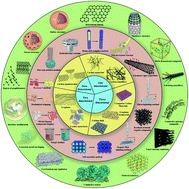Recent advances in nanostructured carbon for sodium-ion batteries
Abstract
Sodium ion batteries (SIBs) have attracted soaring attention lately as a promising alternative to lithium ion batteries (LIBs), because of the vast availability of sodium, its low price and similar physicochemical properties to lithium. In recent years, significant progress of sodium ion battery anodes, which restricted the development of SIBs in the past decades, has been achieved. Extensive investigations have demonstrated that carbonaceous materials can become the most promising anode candidates for SIBs due to their low cost, high stability and electronic conductivity. In this article, a variety of carbon nanomaterials, including carbon quantum dots (CQDs), carbon nanotubes (CNTs), carbon nanofibers (CNFs), carbon nanosheets, and graphene as well as graphite and amorphous carbon anodes for SIBs, are briefly reviewed in view of their different dimensions and graphitization degrees. It also elaborates on research on carbonaceous material modification by doping with heteroatoms, designing various porous morphologies or compositing with organic or inorganic species. Finally, some perspectives and directions on carbon design for SIBs are also proposed. These comprehensive and in-depth discussions will provide an insight into the optimization of carbonaceous materials in SIB anodes.

- This article is part of the themed collection: Recent Review Articles


 Please wait while we load your content...
Please wait while we load your content...